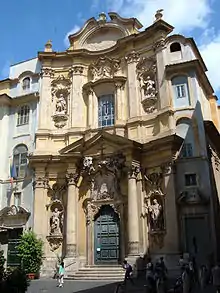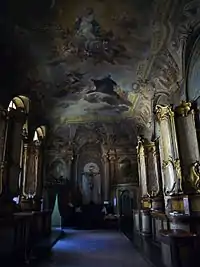Santa Maria Maddalena
The Santa Maria Maddalena is a Roman Catholic church in Rome, named after Saint Mary Magdalene. It is located on the Via della Maddalena, one of the streets leading from the Piazza della Rotonda in the Campo Marzio area of historic Rome.[1]

History
The Clerks Regular, Ministers to the Sick (Italian: Ministri degli Infirmi), order established by Saint Camillus de Lellis, had a church at that location in Rome since 1586 and in the 17th century started the construction of the current church, which was completed in 1699 in the Baroque style.
In seventy years of work several architects were involved including Carlo Quadri, Carlo Fontana (who is thought to have designed the dome) and Giovanni Antonio de Rossi.
It is uncertain who designed the curved main facade, which was finished circa 1735 and is Rococo, an unusual style in Roman church facades. It also displays motifs reminiscent of Borromini. Early guide books credit Giuseppe Sardi with its design. Between 1732 and 1734, however, as architect of the order, the Portuguese architect Manuel Rodrigues dos Santos directed the completion of works at the church. The historian Alessandra Marino believes that it is to Dos Santos, rather than Giuseppe Sardi, that the design for the highly unusual façade decoration should be attributed.[2] The architectural historian Nina Mallory has also maintained that Sardi is unlikely to be the designer of the façade.[3]
To the left of the church is the monastery, constructed circa 1678, by Paolo Amato from Palermo and completed by Carlo Francesco Bizzacheri in the early 1680s.[4]
Interior

The interior is architecturally complex, it has a Borrominesque elongated octagonal nave, with two chapels at each flank.
The Cappella di San Nicola di Bari, financed by Paolo Girolamo della Torre, was begun in 1690 by Mattia de Rossi and finished from 1694-96 by Bizzaccheri whose choice of colour tones would determine the colour scheme of the rest of the church in the mid-18th century.[5][6] In this chapel is the painting Christ, Virgin, and San Nicola di Bari by Baciccia.
To the right is the chapel dedicated of Saint Camillus with the vault frescoed (1744) by Sebastiano Conca.
In the church is also has a painting of San Lorenzo Giustiniani with Infant Jesus by Luca Giordano.
The rococo sacristy is elaborately painted, stuccoed, and decorated with polychrome marble.
See also
References
- Wang, Amelia (2018-08-12). "Rethinking The History Of Rococo: The Unique Decoration Of The Chiesa Di Santa Maria Maddalena". Architecture. Retrieved 2020-02-13.
- If this is so, Dos Santos' earlier training as a cabinet maker would have been critical, as the decoration added to the pre-existing superstructure is commonly encountered in Italian cabinet work of the period, including the cantorie of contemporary churches including S. Maria della Quercia and S. Maria Maddalena itself. Alessandra Marino, 'La decorazione settecentesca della facciata di S. Maria Maddalena: un'occasione per alcune precisazioni sul rococò romano', Quaderni dell'istituto di storia dell'architettura, 15 – 20, 1990 – 2, pp. 789 – 98.
- Mallory, N. A. Rococo Architecture from Clement XI to Benedict XIV, New York & London, 1977
- Blunt, Anthony. Guide to Baroque Rome, Granada, 1982, p.89
- (in German) Gerhard Bissell: Bizzaccheri, Carlo Francesco. In: Allgemeines Künstlerlexikon. Die Bildenden Künstler aller Zeiten und Völker (AKL). Band 11, Saur, München u. a. 1995, ISBN 3-598-22751-5, S. 277 s.
- Nina A. Mallory, Carlo Francesco Bizzacheri (1655-1721), in: Journal of the Society of Architectural Historians 33, 1974, pp. 27-47.
Sources
| Wikimedia Commons has media related to Santa Maria Maddalena (Rome). |
- George Sullivan, 2006, Not Built in a Day: Exploring the Architecture of Rome, Carroll & Graf, ISBN 0-7867-1749-1